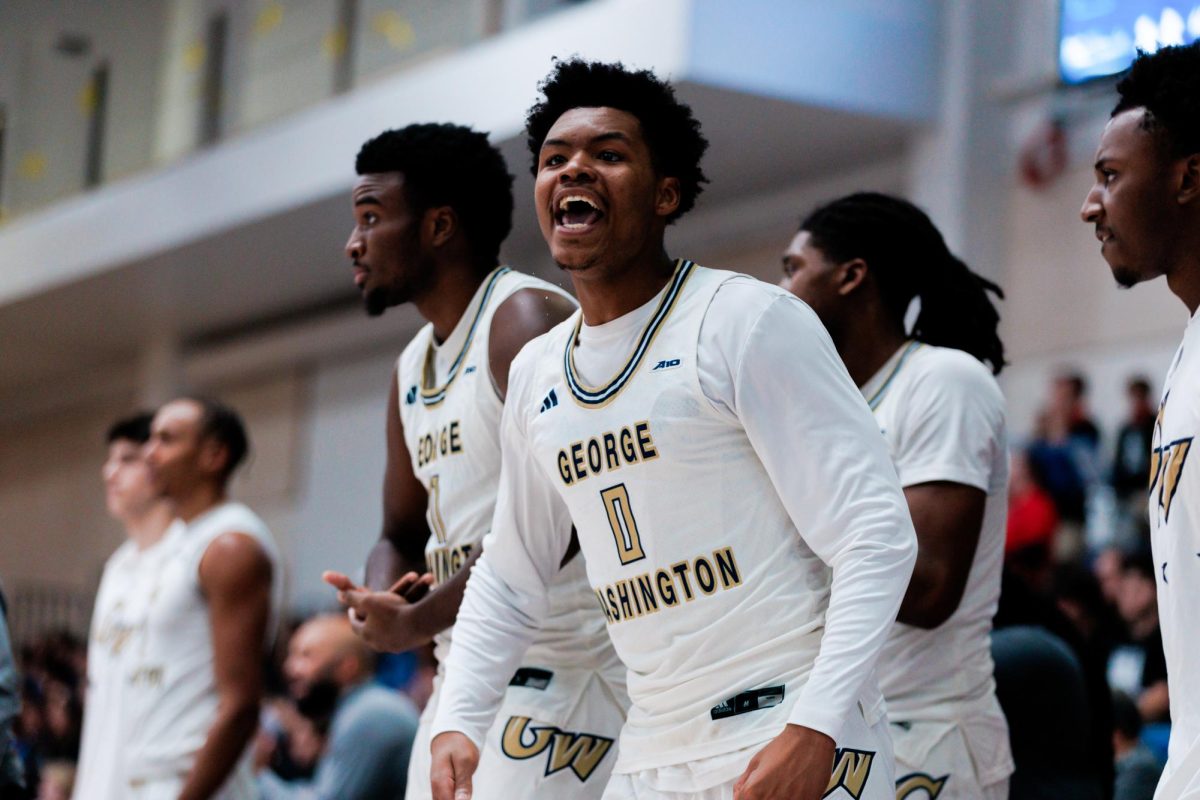Sterile. A band box. Looks like a high school gym.
These sentiments are heard when people first see the Charles E. Smith Center. But in the 1990s, if those words came out of the mouth of a GW opponent, they were quickly eaten. In this decade, the GW Colonials and Colonial women have been almost unbeatable at the intersection of 22nd and G streets.
This year marks the 25th season of basketball at the Smith Center. It took decades before GW built an on-campus facility. Before the Smith Center’s construction from 1973-75, GW played its home games at places as far flung as Fort Myer in Arlington, Va., Uline Arena, Tech High School and the Riverside Coliseum, while practicing at the gym, the Tin Tabernacle, on the Quad.
Since its construction, the Smith Center helped the Colonials to accumulate a 225-93 (94-20 in the 1990s) home record, and an almost identical 222-85 (114-16 in the ’90s) home record for the Colonial women.
One of the endearing qualities of the Smith Center is that GW students use the same court that the teams play games on. (That’s something that will end next year when the Health and Wellness Center opens at 23rd and G streets). The Smith Center court was christened the Larry Tex Silverman Court last year to honor a donor and former basketball player. The court has met other changes through the years, most notably the replacement of a conventional all-purpose floor in the summer of 1989.
Bob Tallent, the first GW men’s coach to walk the sidelines of the Smith Center (1974-’81), greatly admires that improvement upon each visit to the arena.
All-purpose floors were the in-thing, Tallent said. It was hard on the legs.
More important to fans, though, is the improvement in the quality of play. The men’s team opened the arena with a 12-3 record but slowed in the mid-1980s. The Colonial women did not truly start their domination of the court until women’s head coach Joe McKeown’s second season in 1990-1991. Both teams have notched huge wins this decade, in addition to going undefeated three times (two for the men, once for the women), and setting long streaks (the women won 34 home games in a row from ’94 to ’97).
Women’s highlights include GW’s victory over No. 9 Rutgers University, 77-68, in 1991. In 1992, GW hosted the 29-0 University of Vermont in the first round of the NCAA Tournament and won 70-69. The women followed that with five more NCAA Tournament wins at the Smith Center, including the 1997 wins over Northwestern University and Tulane University that helped propel GW to the Sweet 16 and eventually the Elite Eight.
If the men posted any huge wins before the ’90s at the Smith Center, they’ve been lost to history for the most part. There was the day in 1983 when the Colonials scored a Smith Center record 117 points against Catholic and the day in 1985 when Mike Brown scored the Smith Center record of 40. While talking about points, many at GW may remember last year’s 52-point pounding of Duquesne.
In terms of pre-1990s wins for the men, one worth remembering was the 103-77 victory over UMass in the ’88-89 season that ensured GW would not go winless. 1-27 is bad, but 0-28 is worse.
Big GW victories in the ’90s include the defeat of No. 1 UMass in 1995, 78-75, in front of President Clinton and daughter Chelsea. The Colonials beat No. 8 Virginia Tech, 64-47, in the ’95-96 campaign and notched thrilling victories over Xavier in 1998 and 1999.
Despite that success, or in a strange way because of it, it appears GW is intent on following Georgetown’s lead and playing more men’s home games at the larger MCI Center (including the annual BB&T Classic).
Men’s coach Tom Penders agreed that the MCI Center is a great building to play in.
The MCI Center is there for us, but we gotta have the right kind of team (to play against), he said.
The Smith Center has often been criticized for being rather small. Including regular attendees Red Auerbach and CNN’s Wolf Blitzer, the Smith Center holds up to 5,454 of GW’s faithful. Many would like to see this number increase, but zoning complications will almost certainly preclude that from happening.
5,000 is probably good for us now, GW Athletic Director Jack Kvancz said. Sometimes I wish it was 7,500. 7,500 might be an ideal number for us, but what we have is good.
Kvancz said the arena provides for an intense atmosphere. The seats, most notably the student section, are right on the court, often causing difficulty for the opposing team.
It’s the toughest place for an opposing team to win in because of the students, Penders said. Sometimes I can hardly communicate with my team it’s so loud. The fans are really like a sixth man. It’s the best home court I’ve ever coached at.






